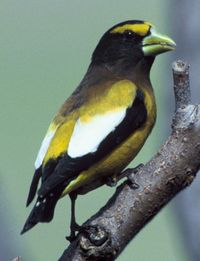| True Finches | ||||||||||
|---|---|---|---|---|---|---|---|---|---|---|

Evening Grosbeak
|
||||||||||
| Scientific classification | ||||||||||
|
||||||||||
| Many, see text |
Finches are passerine birds, often seed-eating, found chiefly in the northern hemisphere and Africa. One subfamily is endemic to the Neotropics. The taxonomic structure of the true finch family, Fringillidae, is somewhat disputed, with some including the Hawaiian honeycreepers as another subfamily (Drepanidinae) and/or uniting the cardueline and fringilline finches as tribes (Carduelini and Fringillini) in one subfamily; the euphonious finches were thought to be tanagers due to general similarity in appearance and mode of life until their real affinities were realized; the buntings and American sparrows were formerly considered another subfamily (Emberizinae). Przewalski's "Rosefinch" (Urocynchramus pylzowi) is now classified as a distinct, monotypic family with no particularly close relatives.
"Classic" or true finches are small to moderately large and have a strong, stubby beaks, which in some species can be quite large. All have 12 tail feathers and 9 primaries. They have a bouncing flight, alternating bouts of flapping with gliding on closed wings, and most sing well. Their nests are basket-shaped and built in trees.
There are many birds in other families which are often called finches. These include many species in the very similar-looking Estrildids or waxbill family, which occur in the Old World tropics and Australia. Several groups of the Emberizidae family (buntings and American sparrows) are also named as finches, including the Darwin's finches of the Galapagos islands, which provided evidence of Darwin's theory of evolution.
Systematics
The systematics of the cardueline finches are contentious. The layout presented here follows the molecular studies of Marten & Johnson (1986) and Arnaiz-Villena et al. (1998, 2001), and takes into account the traditional splitting of the genus Carduelis. The exact position of several genera in the cardueline sequence is tentative.
FAMILY FRINGILLIDAE
- Subfamily Fringillinae - Fringilline
finches; contains only three species, which feed their
young on insects rather than seeds.
- Genus
Fringilla - Bramblings and chaffinches
- Chaffinch (Fringilla coelebs)
Blue Chaffinch (Fringilla teydea)
Brambling (Fringilla montifringilla)
- Chaffinch (Fringilla coelebs)
- Genus
Fringilla - Bramblings and chaffinches
- Subfamily Carduelinae - Cardueline
finches; a much larger group that contains several
genera which feed their young on seeds.
- Genus Eophona - Oriental grosbeaks
Genus Mycerobas - Mycerobas Grosbeaks
Genus Pinicola - Pine grosbeak
Genus Pyrrhula - Bullfinches
Genus Leucosticte - Mountain finches
Genus N.N. - Dark-breasted Rosefinch, "Carpodacus" nipalensis (possibly belongs into Fringillinae)
Genus Carpodacus - Rosefinches (may be 2 or 3 genera; probably includes Haematospiza and possibly also Uragus)
Genus Haematospiza - Scarlet Finch
Genus Uragus - Streaked rosefinches
Genus Serinus - Canaries, seedeaters, serins and African siskins
Genus Carduelis sensu lato- (Sub)Genus Carduelis sensu stricto - Linnets,
goldfinches, twite and cardueline siskins.
(Sub)Genus Chloris - greenfinches and desert finch
(Sub)Genus Acanthis - redpolls
(Sub)Genus Loxia - Crossbills
- (Sub)Genus Carduelis sensu stricto - Linnets,
goldfinches, twite and cardueline siskins.
- Genus Rhodopechys - Trumpeter Finch and
relatives
Genus Coccothraustes - Hawfinch, Evening Grosbeak
Genus Pyrrhoplectes - Gold-naped Finch
Genus Chaunoproctus - Bonin Grosbeak (extinct)
Genus Callacanthis - Spectacled Finch
Genus Neospiza - Sao Tomé Grosbeak
Genus Linurgus - Oriole Finch
Genus Rhynchostruthus - Golden-winged Grosbeak
- Genus Eophona - Oriental grosbeaks
- Subfamily
Euphoniinae - Euphonious finches; endemic
to the Neotropics; formerly treated in
Thraupidae.
- Genus Euphonia, the euphonias
- Genus Chlorophonia, the chlorophonias
References
- Arnaiz-Villena, A.; Álvarez-Tejado, M.; Ruiz-del-Valle, V.; García-de-la-Torre, C.; Varela, P.; Recio, M. J.; Ferre. S. & Martínez-Laso, J. (1998): Phylogeny and rapid Northern and Southern Hemisphere speciation of goldfinches during the Miocene and Pliocene Epochs. Cellular and Molecular Life Sciences 54(9): 1031–1041. DOI:10.1007/s000180050230 PDF fulltext. Erratum, Cellular and Molecular Life Sciences 55(1): 148. DOI:10.1007/s000180050280 PDF fulltext
- Arnaiz-Villena, A.; Guillén, J.; Ruiz-del-Valle, V.; Lowy, E.; Zamora, J.; Varela, P.; Stefani, D. & Allende, L. M. (2001): Phylogeography of crossbills, bullfinches, grosbeaks, and rosefinches. Cellular and Molecular Life Sciences 58: 1159–1166. PDF fulltext
- Clement, Peter; Harris, Alan & Davis, John (1993): Finches and Sparrows: an identification guide. Christopher Helm, London. ISBN 0-7136-8017-2
- Marten, Jill A. & Johnson, Ned K. (1986): Genetic relationships of North American cardueline finches. Condor 88(4): 409-420. PDF fulltext
External links
- Lyric Wild Bird Food - Attracting American Goldfinches to Your Back Yard
- Finch Info & Pictures Information and pictures about various types of finches.
- FinchInfo.com Information on keeping finches as pets.
- Finch videos on the Internet Bird Collection




 216.73.216.91
216.73.216.91 User Stats:
User Stats:
 Today: 0
Today: 0 Yesterday: 0
Yesterday: 0 This Month: 0
This Month: 0 This Year: 0
This Year: 0 Total Users: 117
Total Users: 117 New Members:
New Members:
 216.73.xxx.xx
216.73.xxx.xx
 Server Time:
Server Time: